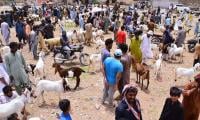KARACHI: Bank lending to the private sector surged to Rs530.40 billion in seven months of 2018/19 fiscal year compared to a year earlier, the central bank’s data showed on Saturday, as companies borrowed to meet working capital needs amid higher input prices and currency depreciation.
Banks extended Rs530.40 billion in loans to the corporate borrowers between July 1, 2018 and January 25, 2019, compared with Rs232.40 billion in the corresponding period of last year, according to the State Bank of Pakistan (SBP) data.
The various branches of commercial banks disbursed Rs374.4 billion loans to private firms, compared with Rs145.8 billion in the same period last year.
Islamic banks lent Rs83.9 billion to the private sector in the seven months to January, compared with Rs14 billion a year ago.
Islamic banking branches of conventional banks extended Rs71.9 billion in loans. That compared with Rs72.4 billion a year earlier, the data showed.
The broad money supply (M2) also increased to 1.80 percent from 0.60 percent a year ago.
Private businesses continued to face headwinds from
rising raw material costs, especially cotton, and petroleum products, which increased the demand for working capital loans.
Furthermore, a sharp depreciation in exchange rate pushed the rupee costs of imported inputs and equipments.
Analysts said private sector credit growth remained high despite tight monetary policy since last year.
The SBP has lifted policy rate by a cumulative 4.5 percentage points since January 2018, while it also raised policy rate by 25 basis points to 10.25 percent this week.
Credit growth is likely to maintain an upward trend over the coming months, despite expectations of further increase in interest rates and slowdown in economic growth.
The sectors where higher demand has been anticipated include manufacturing and electricity, gas and water supply, while demand for the consumer loans would remain slow.
The central bank in its first quarterly report on the state of economy predicted 4.0-4.5 percent real gross domestic product growth in 2018/19 fiscal year, down from its October forecast of 4.7 to 5.2 percent growth for FY19.
Banks were expected to benefit from tax reliefs, announced by the PTI government in second supplementary budget for FY19, on income they earn from providing loans to farmers, small businesses and low-income people to build their home.
Analysts see lending growth in the agriculture, SMEs, and low income housing sectors to increase due to the tax breaks announced in the recent mini-budget.
The headquarters of the Sui Southern Gas Company . — APP FileKARACHI: Sui Southern Gas Company has launched a fresh...
The logo of the ExpoMed Eurasia. — CA MI websiteKARACHI: Pakistan is participating in ExpoMed Eurasia, a leading...
Gold bars are seen in this undated file photo. — AFP/FileKARACHI: Gold prices increased by Rs500 per tola on...
FFBL Head Office building can be seen in Islamabad. — FFBL WebsiteKARACHI: Fauji Fertilizer Bin Qasim Limited has...
Representational file of an BMW car. — AFP FileLAHORE: Small improvements in economic credentials of the country are...
A fuel station worker filling petrol in vehicle at a fuel station in Karachi on Tuesday, April 16, 2024KARACHI: After...







